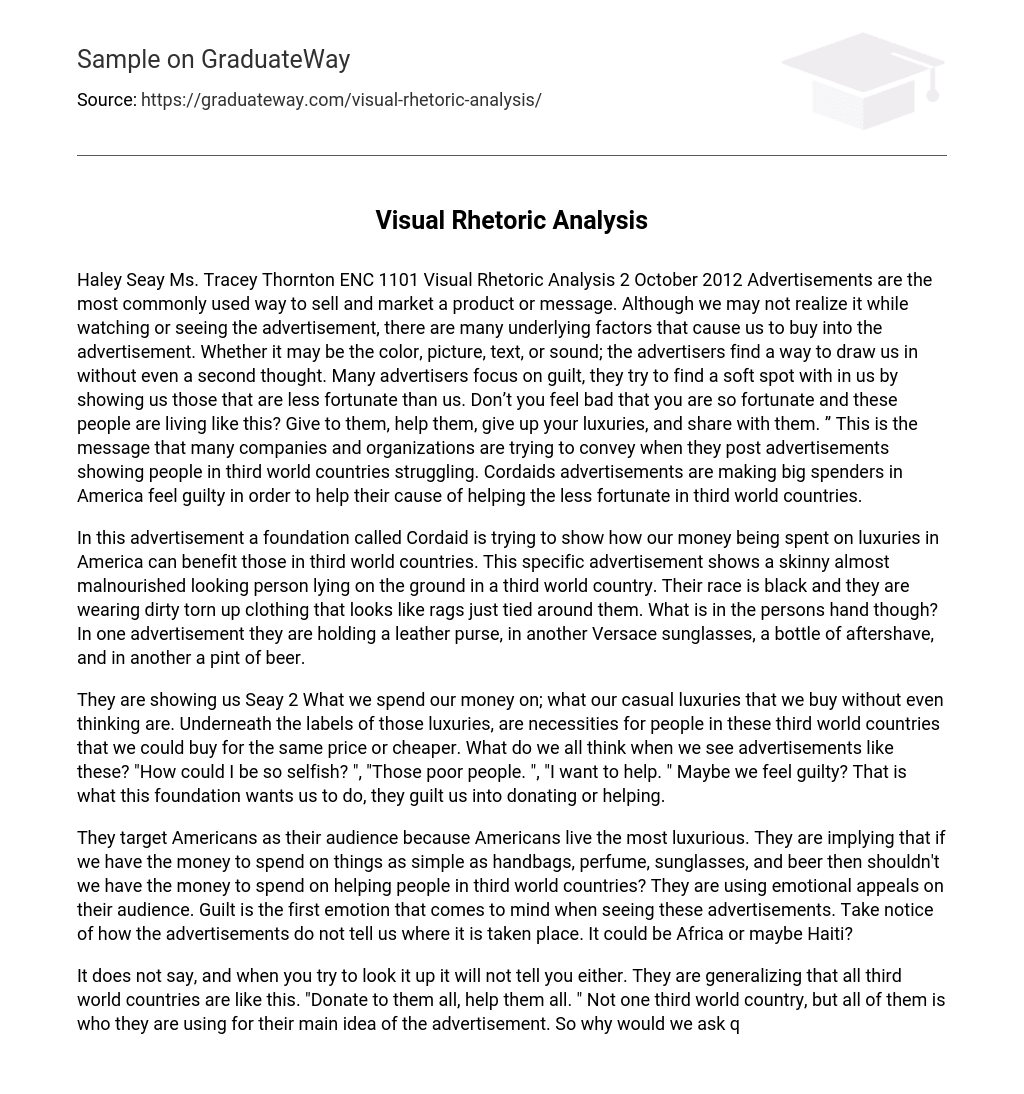Advertisements are commonly used to market products or messages, and while we may not realize it, there are many underlying factors that influence our response to them. Whether it’s the color, picture, text, or sound, advertisers find ways to captivate us effortlessly. One popular tactic is appealing to guilt, leveraging our empathy by showing less fortunate individuals. This approach aims to evoke a sense of privilege and compassion within us, urging us to give up luxuries and share with those in need. Many companies and organizations, such as Cordaids, utilize this strategy in their advertisements to highlight the struggles of people in third world countries and encourage more affluent individuals in America to contribute to their cause.
The advertisement aims to demonstrate how our expenditures on luxurious items in America can help improve the lives of individuals in underdeveloped nations. It features a depiction of a thin individual in a third-world country, appearing to be malnourished, lying on the ground. This person is of black race, wearing tattered and soiled clothing resembling rags. Interestingly, they are holding various luxury items such as a leather purse, Versace sunglasses, a bottle of aftershave, and even a pint of beer in different advertisements.
They are presenting Seay 2, which showcases our spending habits on everyday luxuries that we often purchase without much thought. However, hidden beneath the glamour of these products lie essential needs for individuals in third world countries, which can be obtained for the same price or even cheaper. Whenever we come across advertisements like these, various thoughts may cross our minds – “Am I being selfish?”, “I feel empathy for those less fortunate,” or “I have the desire to provide assistance.” Perhaps, we experience a sense of guilt as well. This foundation aims to provoke such feelings within us, urging us to donate or offer help as a result of this emotional manipulation.
The advertisers focus on targeting Americans as their audience due to their luxurious lifestyle. The underlying message is that if Americans can afford to spend money on luxury items like handbags, perfume, sunglasses, and beer, shouldn’t they be able to allocate funds towards helping people in third world countries? These advertisements employ emotional appeals to elicit guilt from the viewers. Notably, the location of the depicted situations is intentionally left unspecified; it could either be Africa or possibly Haiti.
The advertisement does not provide specific information and researching it yields no answers. The advertisement makes a sweeping generalization that applies to all third-world countries. Their main idea is to donate to all of these nations and offer help to all of them. Instead of focusing on the specific needs of these underprivileged individuals, the advertisement encourages us to alter our lifestyles in order to assist them.
The advertisement lacks background information and support for the foundation’s purpose. Instead, it conveys a message of guilt, criticizing individuals for spending money on themselves rather than helping those in need. This ad also perpetuates the stereotype that all Americans are selfish or greedy. It evokes feelings of shame and guilt for indulging in luxuries rather than assisting underprivileged people from other nations. Are all Americans considered greedy simply because we prioritize spending our money elsewhere?
No, this advertisement aims to evoke a certain emotional response and make us believe that we can make a difference. Will they acknowledge Americans who donate money to those in need within our own country? No. Once again, it relies on an emotional appeal, capitalizing on feelings of guilt and shame. The ad does not explicitly label Americans as greedy or selfish, nor does it require us to donate. However, the image depicted suggests that spending money on our desires could provide basic necessities for those less fortunate.
Yes, it is a dig at Americans, as evident from the clothing worn by the people in these advertisements. Their physical appearances also contribute to the message of the advertisement. By comparing our physical appearances to theirs, the images make us feel guilty, reinforcing the emotions the company wants us to experience.
The appearance of the people, as well as the writing on the image, evokes a certain feeling. It compares the cost of our luxuries with the cost of their necessities, presenting it right in front of our eyes. Do you still feel guilty about your excessive spending? Alternatively, do you believe that Cordaid’s “People in need” campaign is ethically questionable? Regardless of your viewpoint, it is important to acknowledge the tactics used by these campaigners to manipulate our emotions.





